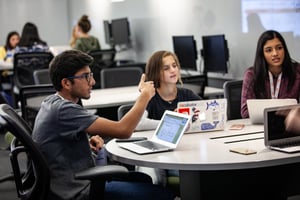Entering a New Era
The year is 2020. It feels surreal as though we should be living in an episode of The Jetsons. While we do not have flying cars, we do have phones where we can see each other. I call it a win. We also have amazingly dynamic technology for the classroom and life. It’s nearly impossible to keep up with it all, let alone understand its influence.
In particular, studying the influence of social media is difficult but important work (Avolio & Kahai, 2003). Technology is ever-changing, causing research to be outdated soon after it is conducted, analyzed, and published. Few would argue that social media has not influenced American society. However, the debate exists on whether the influence is positive or negative.
One of the original intentions of social media was simply to connect individuals. However, social media has become more than connections. Some frown upon social media citing negative effects, using powerful words like addiction. As a researcher and educator, this troubled me. Where was the counter argument? Was there a counter argument?
Inspired to Research for Answers

On a personal level, I enjoy using social media. As a college professor, I found using technology in my classroom exciting and beneficial. But this was all anecdotal. Therefore, using data from a 2018 National Study, I performed a quantitative analysis to explore the influence of social media on college students' social-emotional learning competencies. The purpose of this research was to examine the extent, if any, to which social media influences a college student’s capacity to engage in socially responsible leadership. Said another way, I wanted to see how, if at all, social-emotional learning (SEL) was influenced through college students' use of social media.
While my work now focuses on teaching entrepreneurship to youth, my prior professional experiences in corporate America and institutions of higher education involved college student engagement. As such, I was drawn to see if we, as educators, are successfully preparing college students for career readiness. It’s important work; unfortunately, not one that is often explored with such large scale studies (Ahlquist, 2017; Baek et al., 2012; Papacharissi, 2004). The lack of literature leaves educators with questions on how to best integrate technology into the classroom to help shape the student experience.
The Study: Social Media Proficiency and SEL

This quantitative, cross-sectional study used data collected as part of the 2018 Multi-Institutional Study of Leadership (MSL). Data was collected online between January and April 2018. The total sample size for the national data set was 256,289 cases. The national response rate was 29 percent, with a total number of 54,430 completed cases. To answer the research questions, 14,564 cases were selected per the sample selection parameters. While there were a number of questions studied (and more information can be found here), this blog focuses on the extent to which social media proficiency (i.e., how well students knew how to use social media) influenced social-emotional learning, including:
- Self-awareness: Self-awareness has two elements: awareness of personality and mindfulness. To be aware of one’s own personality means to understand one’s aspirations, talents, interests, and limitations. To be mindful calls for “a propensity to be an accurate observer of your current actions and state of mind” (Higher Education Research Institute, 1996, p. 31),
- Congruence: Congruence means to think, feel, and act consistently with one’s values while remaining authentic,
- Commitment: Commitment is grounded in the need to enact change through leadership. This change cannot come to fruition with only a snippet of time, but rather requires a purposeful investment of time and energy,
- Common Purpose: Common purpose means that a group has a mutual set of values and vision,
- Collaboration: Collaboration means to work effectively with others toward this common purpose. It involves sharing responsibility, authority, and credit (Higher Education Research Institute, 1996),
- Controversy With Civility: Controversy with civility is defined as “disagreements and disputes which arise when those holding contrasting perspectives and opinions are encouraged to share their views… committing themselves to understand the nature of the disagreement” (Higher Education Research Institute, 1996, p. 60), and
- Citizenship: Citizenship finds its crux in the interconnectedness of individuals. Terms such as duty and privilege are used to define its core tenet of serving one another toward positive social change (Higher Education Research Institute, 1996).
Does Digital Literacy Matter?
Social media proficiency requires technological knowledge and savvy, or digital literacy. Digital literacy includes “technical, cognitive and social-emotional perspectives of learning with digital technologies” (Ng, 2012, p. 1066). A successful digitally literate individual will present skills that allow them to adapt to new technology quickly and effectively while demonstrating the ability to continue to expand their technological knowledge.
.jpg?width=300&name=INCUBATOR%20(1%20of%2052).jpg) In addition to technical know-how, individuals must be aware of the social-emotional component that requires respect and discretion (Ng, 2012). Digital literacy aims to “teach students to thoughtfully question and consider the choices they make as they participate in various media” (De Abreu, 2010, p. 30) rather than avoiding technology. Digital literacy teaches students to engage in online activities that are “legal, ethical, safe, responsible, and respectful” (Greenhow, 2010, p. 25).
In addition to technical know-how, individuals must be aware of the social-emotional component that requires respect and discretion (Ng, 2012). Digital literacy aims to “teach students to thoughtfully question and consider the choices they make as they participate in various media” (De Abreu, 2010, p. 30) rather than avoiding technology. Digital literacy teaches students to engage in online activities that are “legal, ethical, safe, responsible, and respectful” (Greenhow, 2010, p. 25).
Too often, digital literacy is assumed in a group called digital natives. Digital natives are most often defined as the generation born after 1980 (Ahlquist, 2017; Prensky, 2001), who are assumed to have grown up with technology as a constant and integral part of their lives (Prensky, 2001). While students today arguably are exposed to technology, exposure is often incorrectly associated with proficiency. In turn, students are not provided formal instruction on how to use social media, based on the assumption that they have acquired this knowledge through informal practices.
Results Inform Priorities in the Classroom
Results from this study show that social media proficiency had a statistically meaningful and positive impact on all six outcomes. Therefore, the assumption that teaching the use of technology in the classroom is unnecessary and repetitive cannot be accepted. We, as educators, must ensure students demonstrate high social media proficiency. Digital literacy is not intuitive or inherent and must be intentionally learned (Ng, 2012). Technology needs to be prioritized and given formal space in the classroom.
 Currently, educators’ prototypical consideration and application of social media to students is in marketing or as a tool sprinkled into coursework about appropriate behaviors. Social media is capable of much more. Perhaps the cornerstone of implications for practice is in how to intentionally use technology in the classroom.
Currently, educators’ prototypical consideration and application of social media to students is in marketing or as a tool sprinkled into coursework about appropriate behaviors. Social media is capable of much more. Perhaps the cornerstone of implications for practice is in how to intentionally use technology in the classroom.
Integrating Technology Into the Classroom
Findings from this research are limited by the quantitative design utilized for the study. However, several recommendations can be made related to the ways in which educators could integrate social media into the classroom.
- Educators should frame social media as a positive addition to an education, rather than something that hinders learning.
- Educators should ensure social media becomes important for the right reasons. Similar to the Hippocratic oath, students are instructed to “do no harm” when it comes to social media, rather than “doing good.” We are focused on telling students what not to do online, rather than showing how to positively embrace technology to grow their capacity to practice SEL.
- Educators should be intentional and dedicate at least one learning outcome that specifically addresses technology in the classroom. Currently, learning outcomes mostly lack digital learning objectives (Ahlquist, 2017).
- Educators should use technology in the classroom, specifically social media! For example, a hashtag could be established on Twitter for students to stay connected to one another or provide resources and support to one another.
- Educators should add technological competence to their professional development. Educators need to be intentional, knowledgeable, and current with all that technology offers (Aiken, 2016; Cabellon & Brown, 2017). Hesitation to embrace social media and technology in the classroom (Martínez-Alemán, 2014) will result in a lack of using technology in the classroom, creating a self-fulfilling prophecy.
It is important to acknowledge and support the technological evolution that is occurring. This support comes in the form of not only embracing the use of social media but intentionally supporting students during their exploration of technology and social media platforms. Current students are plagued with labels that assume they are experts in using technology. While they may be more inclined to understand how to use this technology, they may not understand the deep influences it can have on their social-emotional learning. This necessary meaning-making was exposed as critical in this study, and educators must heed the call to fill this void.
How are you using social media to elevate your students' educational experience? We'd love to hear.
